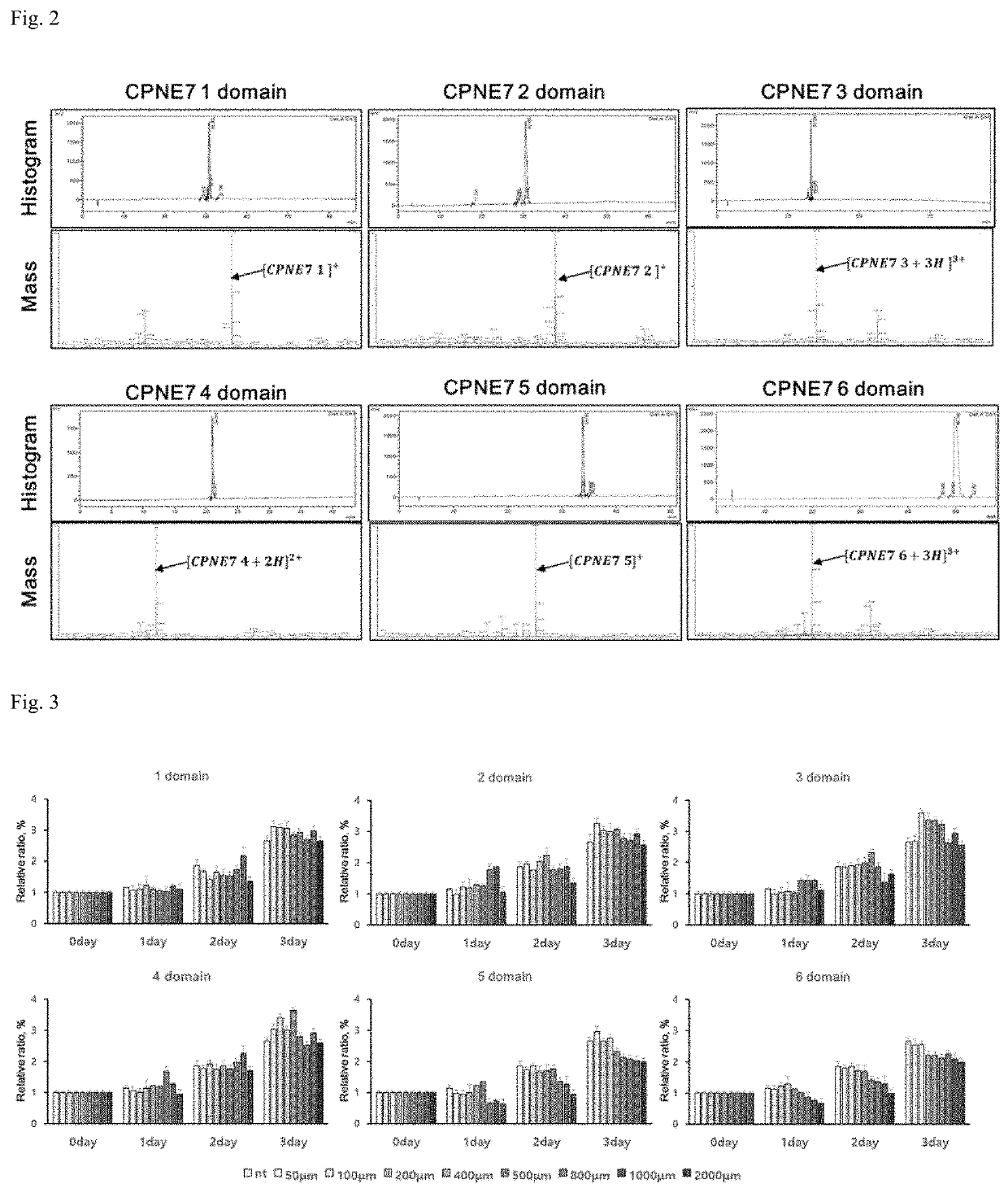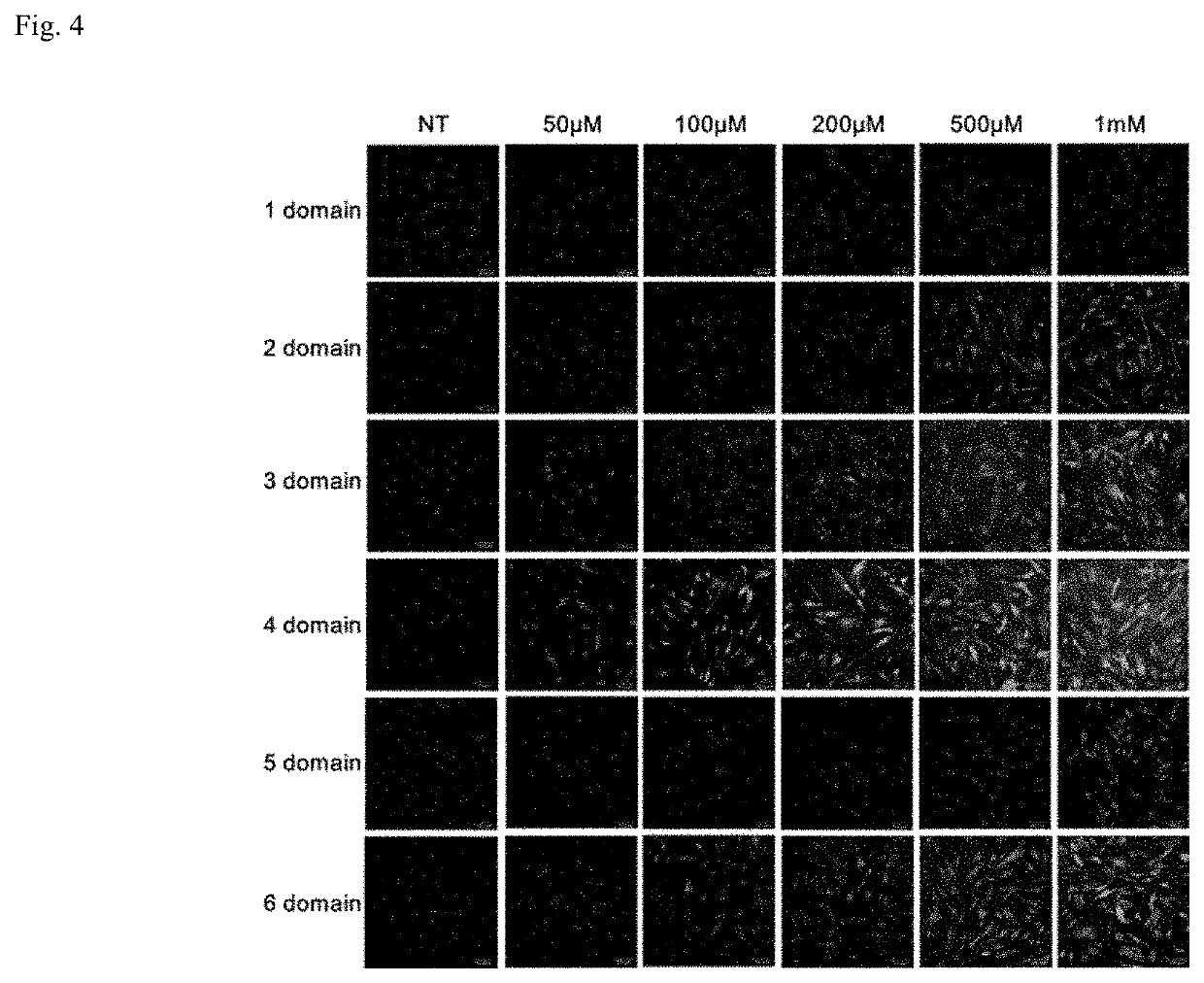Dual functional novel peptide having cell permeability and bone tissue regeneration ability, and use thereof
- Summary
- Abstract
- Description
- Claims
- Application Information
AI Technical Summary
Benefits of technology
Problems solved by technology
Method used
Image
Examples
example 2
of Peptides
[0053]The peptides set forth in SEQ ID NOS: 1 to 6 were synthesized from the C-terminus by an Fmoc solid phase chemical synthesis method using a synthesizer. Rink resin (0.075 mmol / g, 100˜200 mesh, 1% DVB crosslinking) conjugated with fmoc-(9-fluorenylmethoxycarbonyl) as a blocking group was used for the synthesis. 50 mg of Rink amide MBHA resin was added into the synthesizer, the resin was swollen with DMF and a 20% piperidine / DMF solution was used to remove the Fmoc-group. 5, 10 and 15 equivalents of a 0.5M amino acid solution (solvent: DMF), 1.0M DIPEA (solvent: DMF & NMP) and 0.5M HBTU (solvent: DMF) were reacted under a nitrogen atmosphere for one to two hours. Whenever the deprotection and coupling steps were completed, the reaction solution was washed twice with DMF and methanol. After the last amino acid was coupled, the Fmoc-group was removed by deprotection.
[0054]Synthesis was identified through a ninhydrin test method. After identifying Fmoc group removal, a re...
example 3
n of In-Vitro Cytotoxicity of Synthetic Peptides
[0055]A cell viability test was performed to evaluate the cytotoxicity of the peptides set forth in SEQ ID NOS: 1 to 6 synthesized in Example 2 above. For this purpose, dental pulp stem cells were seeded at a density of 9×103 cells per well into each well of a 96-well polystyrene plate in a Dulbecco's Modified Eagle's Medium (Gibco, USA) supplemented with 10% FBS (fetal bovine serum) and a 1% antibiotic-antimycotic solution (Thermo Fisher Scientific, USA), and then cultured for 24 hours. Each well was treated with various concentrations (50 μM, 100 μM, 200 μM, 400 μM, 500 μM, 800 μM, 1000 μM and 2000 μM) of the peptides set forth in SEQ ID NOS: 1 to 6. After 24 hours (1 day), 48 hours (2 days) and 72 hours (3 days), an MTT assay was performed to identify the cytotoxicity of the peptides. For the MTT assay, the medium was removed 24 hours, 48 hours, and 72 hours after treatment with peptide and each well was then treated with a mixture ...
example 4
ation of Cell Permeability of Synthetic Peptides
[0057]In order to identify the cell permeability of the peptides set forth in SEQ ID NOS: 1 to 6 synthesized in Example 2, fluorescein isothiocyanate (FITC) was attached to the N-terminus of each peptide. Dental pulp stem cells were seeded at a density of 3×104 cells into a 4-well chamber and cultured in DMEM medium for 24 hours for cell stabilization. 24 hours later, the cells were treated with the FITC-labeled peptide at various concentrations (50 μM, 100 μM, 200 μM, 500 μM, 1000 μM) for 30 minutes. The cells were treated with 100 ng / ml of copine 7 protein for 30 minutes in order to compare the cell permeability thereof with the peptide. Then, in order to compare the intracellular permeation behaviors of these peptides or the protein, each well was treated with 4% paraformaldehyde, fixed at room temperature for 10 minutes, treated with 0.5% Triton-X 100, and cultured at room temperature for 15 minutes. Then, the cells were blocked wi...
PUM
| Property | Measurement | Unit |
|---|---|---|
| Body weight | aaaaa | aaaaa |
| Permeability | aaaaa | aaaaa |
Abstract
Description
Claims
Application Information
 Login to View More
Login to View More - R&D
- Intellectual Property
- Life Sciences
- Materials
- Tech Scout
- Unparalleled Data Quality
- Higher Quality Content
- 60% Fewer Hallucinations
Browse by: Latest US Patents, China's latest patents, Technical Efficacy Thesaurus, Application Domain, Technology Topic, Popular Technical Reports.
© 2025 PatSnap. All rights reserved.Legal|Privacy policy|Modern Slavery Act Transparency Statement|Sitemap|About US| Contact US: help@patsnap.com



